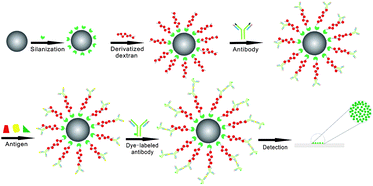Dextran-silane coating chemistry for SiO2-based suspension array system
Abstract
Suspension arrays provide an efficient way to identify and quantify

* Corresponding authors
a
Suzhou Institute of Nano-tech and Nano-bionics, Chinese Academy of Sciences, Suzhou, P. R. China
E-mail:
jli2006@sinano.ac.cn
Fax: (+86)512-62603079
Tel: (+86)512-62872644
b Technical Institute of Physics and Chemistry, Chinese Academy of Sciences, Beijing, P. R. China
c Graduate University of Chinese Academy of Sciences, Beijing, P. R. China
Suspension arrays provide an efficient way to identify and quantify

 Please wait while we load your content...
Something went wrong. Try again?
Please wait while we load your content...
Something went wrong. Try again?
R. Cao, Z. Lu, D. Duan, Z. Zhao, X. Du and J. Li, Polym. Chem., 2011, 2, 2574 DOI: 10.1039/C1PY00279A
To request permission to reproduce material from this article, please go to the Copyright Clearance Center request page.
If you are an author contributing to an RSC publication, you do not need to request permission provided correct acknowledgement is given.
If you are the author of this article, you do not need to request permission to reproduce figures and diagrams provided correct acknowledgement is given. If you want to reproduce the whole article in a third-party publication (excluding your thesis/dissertation for which permission is not required) please go to the Copyright Clearance Center request page.
Read more about how to correctly acknowledge RSC content.
 Fetching data from CrossRef.
Fetching data from CrossRef.
This may take some time to load.
Loading related content
